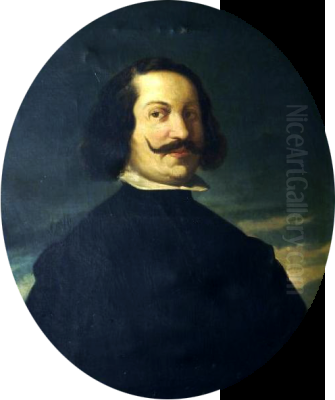
Juan de Valdés Leal stands as one of the most compelling and distinctive figures of the Spanish Golden Age, a period of extraordinary artistic and cultural flourishing. Active primarily in Seville during the latter half of the 17th century, Valdés Leal was a multifaceted artist – a painter, sculptor, etcher, and even an architect – whose work embodies the dramatic intensity, profound religiosity, and somber reflections on mortality characteristic of the late Baroque era in Spain. His art, often overshadowed internationally by his contemporary Bartolomé Esteban Murillo, possesses a raw, visceral power and a penchant for the macabre that sets him apart and continues to fascinate scholars and art lovers alike.
Early Life and Artistic Formation in Andalusia
Juan de Valdés Leal was born in Seville on May 4, 1622. His father, Fernando de Nisa, was a goldsmith of Portuguese descent, and his mother, Antonia de Valdés Leal, was Andalusian. It was from his mother that he took the surname by which he is known. While Seville was his birthplace, much of his early artistic training is believed to have taken place in Córdoba, a significant cultural center in Andalusia.
The precise details of his earliest instruction are somewhat obscure, but it is widely accepted that he was a pupil of Antonio del Castillo y Saavedra in Córdoba. Castillo, a respected painter known for his narrative clarity and somewhat sober style, would have provided Valdés Leal with a solid foundation in drawing and composition. However, the young artist's temperament and artistic vision would soon lead him down a path of greater dynamism and emotional intensity than his master. Other early influences likely included the works of older Sevillian masters like Francisco de Herrera the Elder, whose vigorous brushwork and dramatic flair may have resonated with Valdés Leal's own inclinations.
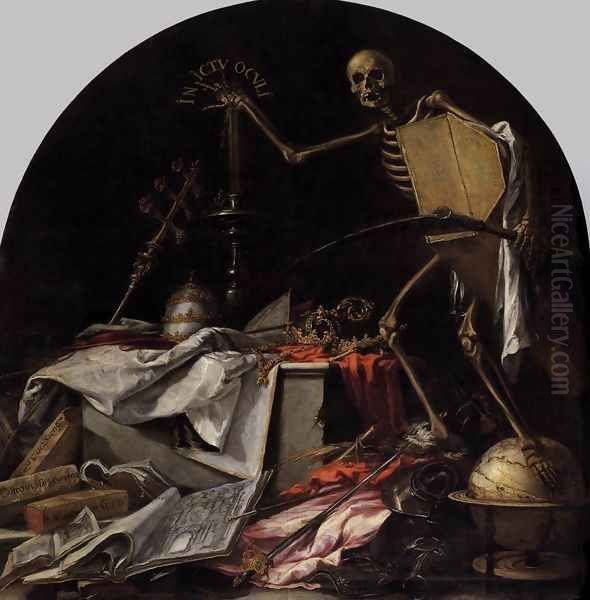
By 1647, Valdés Leal had married Isabella Carasquilla (or Martínez de Morales), who was herself a painter, though little of her work survives. This union marked the beginning of a family that would also become involved in the arts; his children, notably Lucas Valdés and Luisa Rafaela de Valdés, would later assist him in his workshop and become artists in their own right. During his time in Córdoba, he undertook several commissions, including paintings for the convent of the Carmelitas Calzados and for the Hieronymite monastery of Buenavista outside Seville, demonstrating his growing reputation.
The Artistic Crucible of Seville
In 1656, Valdés Leal permanently relocated to Seville. This city was, at the time, one of Spain's most important artistic centers, despite having passed its economic zenith. It boasted a rich artistic heritage, having been home to masters like Diego Velázquez (before his move to the court in Madrid), Francisco de Zurbarán, and Alonso Cano. Upon his arrival, Valdés Leal entered a vibrant, if competitive, artistic scene.
His style began to mature rapidly in Seville. He absorbed the influences around him but forged a distinct artistic identity. While Zurbarán’s powerful, statuesque figures and profound spirituality had defined an earlier phase of Sevillian painting, and Murillo was rising to prominence with his softer, more idealized, and emotionally accessible religious scenes and charming genre paintings, Valdés Leal offered something different. His work was characterized by a nervous energy, a dramatic use of light and shadow (chiaroscuro), and a palette that, while often dark, could erupt into passages of startling, almost violent color.
He quickly established himself, receiving significant commissions for churches and religious orders. An early important commission in Seville was a series of paintings depicting the History of Saint Jerome for the Hieronymite monastery of Buenavista (c. 1657), showcasing his narrative skill and already evident dramatic tendencies. His figures were often elongated, their gestures emphatic, and their expressions conveying intense emotion, from ecstatic devotion to profound suffering.
The Seville Academy and Artistic Rivalry
Valdés Leal played a crucial role in the formal organization of artistic life in Seville. In 1660, alongside his contemporary Bartolomé Esteban Murillo and others like Francisco de Herrera the Younger, he was instrumental in founding the Academia de Bellas Artes (Academy of Fine Arts) of Seville. This institution aimed to provide structured training for young artists, emphasizing life drawing and the study of established masters. Valdés Leal served as its president or director from 1663 to 1666, following Murillo's initial tenure.
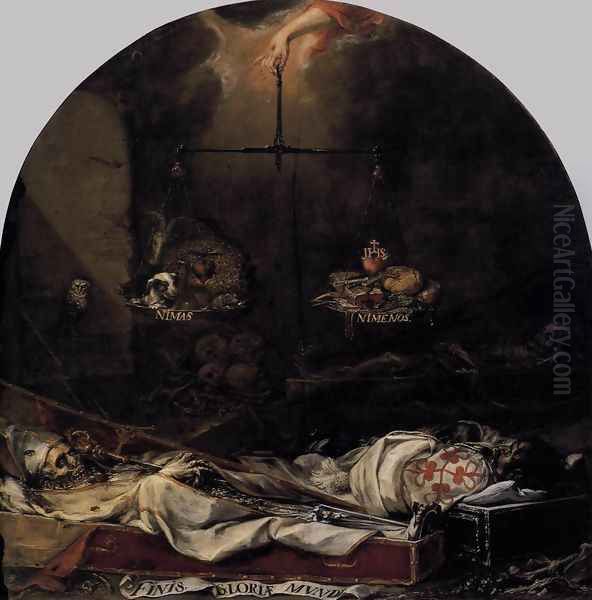
The relationship between Valdés Leal and Murillo is a subject of much art historical discussion. They were the two leading painters in Seville during this period, yet their artistic temperaments and styles were markedly different. Murillo’s art, with its gentle piety, sweet-faced Madonnas, and idealized saints, appealed to a broad public and secured him immense popularity. Valdés Leal’s work, in contrast, was often more challenging, confronting viewers with the harsh realities of sin, suffering, and death. Anecdotal accounts suggest a degree of rivalry and perhaps even animosity between the two, though concrete evidence is scarce. What is clear is that their contrasting approaches provided a rich artistic dialogue within the Sevillian school. While Murillo's influence was pervasive, Valdés Leal maintained his unique, more astringent vision.
Other notable painters active in Spain during Valdés Leal's lifetime, or whose influence was felt, included the aforementioned Velázquez, Zurbarán, and Alonso Cano. In Madrid, artists like Juan Carreño de Miranda and Francisco Rizi were prominent figures at the court. Jusepe de Ribera, though Spanish, worked primarily in Naples, but his powerful tenebrism had a significant impact on Spanish painting. Mateo Cerezo the Younger and Antonio de Pereda, known for his vanitas still lifes, were also contemporaries whose works contributed to the rich tapestry of Spanish Baroque art.
Masterpieces of Moral Allegory: The Vanitas Paintings
Perhaps the works for which Juan de Valdés Leal is most famous are the two large canvases painted in 1672 for the church of the Hospital de la Santa Caridad (Hospital of Holy Charity) in Seville: In Ictu Oculi ("In the Blink of an Eye") and Finis Gloriae Mundi ("The End of Worldly Glory"). These paintings, often referred to as the Postrimerías (Last Things), are powerful and unsettling meditations on the transience of life, the vanity of worldly possessions, and the inevitability of death and judgment.
In Ictu Oculi depicts a skeletal figure, Death, triumphantly extinguishing a candle, symbolizing the snuffing out of life. The skeleton stands amidst a jumble of objects representing worldly power, knowledge, and pleasure: a bishop's mitre, a king's crown, armor, books, scientific instruments, and a globe. The Latin inscription underscores the swiftness of death. The painting is a stark reminder that death comes for everyone, regardless of status or achievement, and that earthly glories are fleeting. The dynamic composition, the dramatic lighting focusing on the gleam of the skeleton and the objects, and the almost palpable sense of decay make this an unforgettable image.
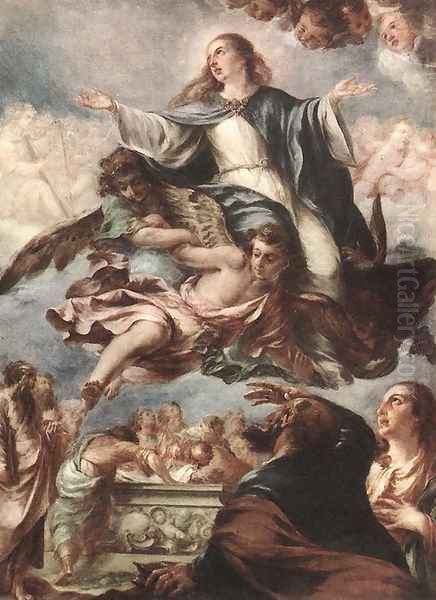
Finis Gloriae Mundi is even more macabre. It presents a crypt with two decaying corpses in open coffins. One is a bishop, identifiable by his vestments, and the other a knight of the Order of Calatrava, indicated by the cross on his decaying shroud. Maggots and worms crawl over their decomposing flesh. Above them, the hand of Christ holds a set of scales, weighing the good deeds ("Ni más" – No more) against the bad deeds ("Ni menos" – No less) of humanity, symbolizing the Last Judgment. The painting is a visceral confrontation with the physical corruption of death and a solemn warning about the ultimate accountability for one's life.
These two paintings were commissioned by Don Miguel Mañara, the charismatic and reformed nobleman who headed the Brotherhood of Holy Charity. Mañara's own life story, one of youthful profligacy followed by profound religious conversion and dedication to charitable works, informed the stark moral message of these commissions. Valdés Leal, with his penchant for the dramatic and the grim, was the perfect artist to realize Mañara's vision. These works are considered among the most potent expressions of the vanitas theme in Baroque art, a theme particularly resonant in a Spain grappling with political decline and religious fervor.
Other Notable Works and Commissions
Beyond the Postrimerías, Valdés Leal produced a significant body of work throughout his career. His religious paintings often depicted scenes of martyrdom and intense spiritual experiences, allowing him to explore the extremes of human emotion and physicality.
Among his notable commissions are:
The Altarpiece of the Convent of San Jerónimo de Buenavista (c. 1657-1658): This series included scenes like The Temptation of St. Jerome and The Flagellation of St. Jerome, showcasing his early mastery of dramatic narrative.
Paintings for the Church of the Carmelitas Calzados in Córdoba: Including Elijah's Sacrifice and Elijah and the Prophets of Baal, demonstrating his ability to handle complex, multi-figure compositions with dynamic energy.
The Assumption of the Virgin (c. 1659, National Gallery of Art, Washington D.C.): A work that shows a more vibrant palette and a swirling, upward movement, characteristic of Baroque depictions of this theme.
The Immaculate Conception with Two Donors (c. 1661, National Gallery, London): While Murillo was the preeminent painter of Immaculate Conceptions in Seville, Valdés Leal also tackled this popular subject, albeit with his own distinct, less idealized approach.
Allegory of Vanity (c. 1660, Wadsworth Atheneum, Hartford): A smaller vanitas piece that predates the Hospital de la Caridad works, showing his early interest in this theme. An angel points to a skull and other symbols of transience, while a bubble, a classic emblem of fragility, floats nearby.
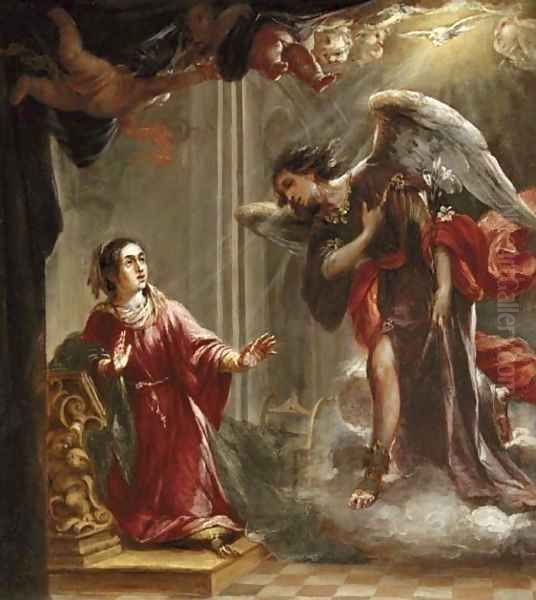
Works for the Cathedral of Seville: Including paintings of saints and apostles, contributing to the rich artistic decoration of this monumental edifice.
The Beheading of St. John the Baptist (Museo de Bellas Artes, Seville): A typically dramatic and somewhat gruesome depiction of the saint's martyrdom, emphasizing the raw emotion of the scene.
Christ Carrying the Cross (c. 1660, Meadows Museum, Dallas): A powerful image conveying the suffering of Christ, notable for its expressive intensity.
His style evolved over time. While always retaining a certain dramatic vigor, his later works sometimes show a looser brushstroke and a brighter, more flickering light, perhaps influenced by Venetian painting or the evolving tastes of the late Baroque. He was also a proficient etcher, producing prints that disseminated his compositions and themes.
Valdés Leal as Sculptor and Architect
Valdés Leal's talents were not confined to painting. He was also active as a sculptor and architect, though fewer examples of his work in these media survive or are definitively attributed. In 17th-century Spain, the boundaries between these artistic disciplines were often fluid, with painters frequently designing altarpieces that incorporated sculpture and architectural elements.
His involvement in architectural design is evidenced by his work on retablos (altarpieces), which were complex structures often involving intricate carving and gilding. He is known to have designed the high altarpiece for the church of the Carmelitas Calzados in Córdoba and was involved in the design of the monumental high altarpiece for the church of the Hospital de la Caridad in Seville, for which he also painted the famous Postrimerías. This latter project, overseen by Miguel Mañara, was a comprehensive decorative scheme involving painting, sculpture, and architecture, aimed at conveying the core tenets of the Brotherhood.
As a sculptor, he is credited with some polychromed wood figures, though attributions can be challenging. His understanding of three-dimensional form, evident in his powerfully modeled painted figures, would have served him well in sculptural endeavors. This multidisciplinary approach was not uncommon among ambitious artists of the period, such as Alonso Cano, who was also a painter, sculptor, and architect.
Personal Life, Character, and Workshop
Valdés Leal was described by early biographers, such as Antonio Palomino (a painter and art historian who knew him), as having a proud and somewhat difficult temperament. Palomino characterized him as vain and perhaps envious of Murillo's greater fame and fortune. This characterization has colored perceptions of Valdés Leal, sometimes leading to him being cast as the "dark" counterpart to Murillo's "light." While such biographical details should be treated with caution, they hint at a strong, perhaps uncompromising personality.
His workshop was a family affair. His wife, Isabella Carasquilla, was a painter. Their son, Lucas Valdés (1661-1724), became a significant painter and engraver in his own right, often working in a style that reflected his father's influence but also adapted to later trends. He assisted his father on major projects, including the decoration of the Hospital de los Venerables Sacerdotes in Seville. His daughters, Luisa Rafaela de Valdés and María de la Concepción, were also recorded as painters, though less is known about their individual careers. The collaborative nature of Baroque workshops meant that family members often played crucial roles in fulfilling large commissions.
Later Years and Legacy
Juan de Valdés Leal remained active until shortly before his death. In his later years, he continued to receive important commissions, including a series of paintings for the Hospital de los Venerables Sacerdotes in Seville, where his son Lucas also contributed significantly. He suffered a stroke in 1688 or 1689, which likely curtailed his artistic activities. He died in Seville on October 15, 1690, and was buried in the Church of San Andrés.
For a long time, Valdés Leal's reputation was somewhat eclipsed by that of Murillo, whose more accessible and pleasing style enjoyed immense popularity, especially during the 18th and 19th centuries. Valdés Leal's work, with its often stark and unsettling themes, was perhaps less suited to the prevailing tastes of those periods. However, in the 20th and 21st centuries, there has been a significant re-evaluation of his art. His dramatic intensity, his psychological insight, and his unflinching engagement with the themes of mortality and salvation are now recognized as powerful and unique contributions to Spanish Baroque art.
His influence can be seen in the work of his son Lucas Valdés and other later Sevillian painters. More broadly, his expressive power and his exploration of the darker aspects of the human condition can be seen as prefiguring certain aspects of Romanticism and even later Expressionist movements. Artists like Francisco Goya, though working in a different era and context, shared Valdés Leal's fascination with the macabre and the capacity for human suffering, albeit expressed through a different artistic language.
Valdés Leal in Art History: Exhibitions and Scholarship
Modern scholarship has shed much light on Valdés Leal's career and artistic significance. Numerous exhibitions have featured his work, allowing contemporary audiences to experience its power firsthand. For instance, his paintings from the Hospital de la Caridad are a major draw in Seville. Works like Christ Carrying the Cross have been included in international exhibitions of Spanish Baroque art, such as one at the Albuquerque Museum in 2016. The Meadows Museum in Dallas, which has a significant collection of Spanish art, has also highlighted his contributions, for example, by borrowing works like The Ecstasy of Saint Francis in 2023.
Academic studies and monographs have explored the complexities of his iconography, his relationship with patrons like Miguel Mañara, and his place within the broader context of Counter-Reformation spirituality and Sevillian society. Books like Splendours of the Spanish Baroque (1993) and specialized catalogues have helped to disseminate knowledge about his art. His role as a co-founder and director of the Seville Academy is also recognized as an important contribution to artistic education in Spain.
Conclusion: The Enduring Power of a Baroque Visionary
Juan de Valdés Leal was more than just a painter of death and decay. He was a profound religious artist whose work grappled with the fundamental questions of life, death, and salvation. His art is a product of its time – the fervent, often anxious, spirituality of Counter-Reformation Spain – but its emotional power and artistic virtuosity transcend its historical context.
His dramatic compositions, his bold use of color and light, and his unflinching gaze into the abyss of human mortality make his paintings unforgettable. While contemporaries like Murillo offered solace and idealized beauty, Valdés Leal confronted his viewers with uncomfortable truths, urging them to contemplate the "Last Things" and the ultimate meaning of their lives. In doing so, he created some of the most powerful and enduring images of the Spanish Baroque, securing his place as one of its most original and compelling masters. His legacy is that of an artist who dared to explore the shadows, finding in them a profound and unsettling beauty.